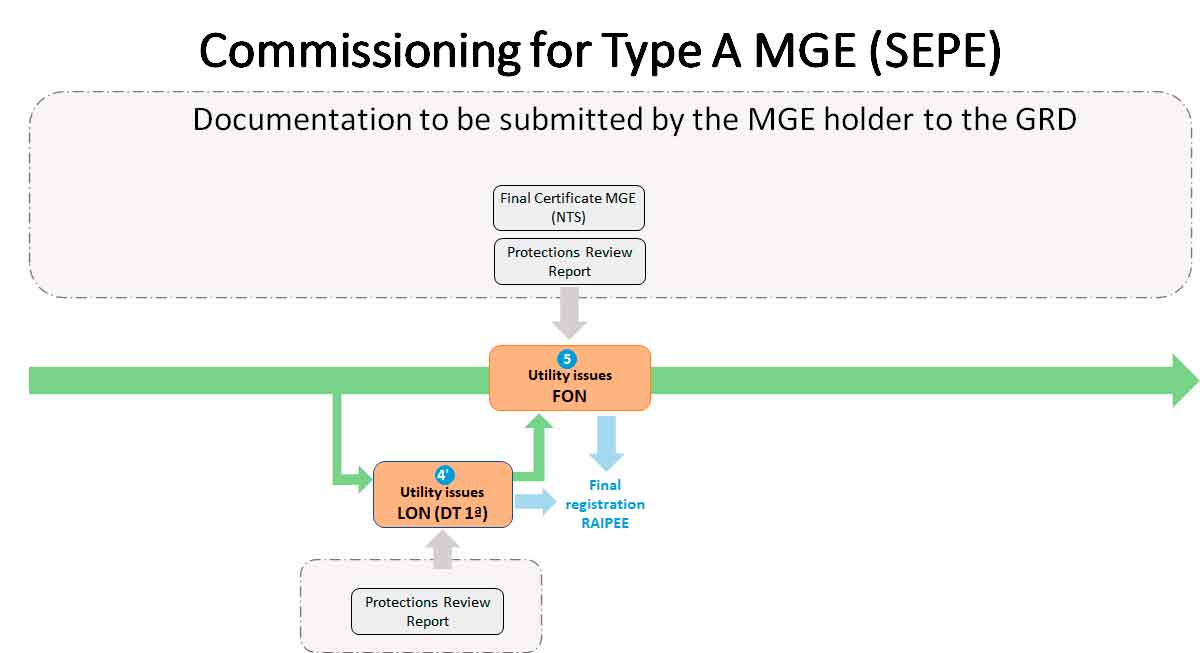Process to put into service new power-generating modules
Connected to the distribution grid in mainland spain
- PGM related to self-consumption installations that cannot export energy to the grid ("Modalidad de autoconsumo sin excedentes").
- PGM related to self-consumption installations that can export energy to the grid ("Modalidad de autoconsumo con excedentes") whose maximum capacity is equal to or below 15kW located in urban regions (located on urbanized land with the facilities and services required by urban planning legislation)
- A Type: PGM whose connection point is below 110kV, and maximum capacity is greater or equal to 0.8kW and smaller or equal to 100kW.
- B Type: PGM whose connection point is below 110kV, and maximum capacity is greater than 100kW and smaller or equal to 5MW.
- C Type: PGM whose connection point is below 110kV, and maximum capacity is greater than 5MW and smaller or equal to 50MW.
- D Type: PGM whose connection point is greater or equal to 110kV, or maximum capacity is greater than 50MW.
- Energization Operational Notification (EON): means a notification issued by the DSO to the PGM facility owner before the energization of its internal network.
- Interim Operational Notification (ION): This means a notification issued by the DSO to a PGM facility owner, which allows them to operate the PGM by using the grid connection for a limited period and to initiate compliance tests to ensure compliance with the relevant specifications and requirements.
- Final Operational Notification (FON): means a notification issued by the DSO to a PGM facility owner, allowing it to operate by using the grid connection. The PGM facility owner should deliver the “MGE Final Certificate” as specified in the Technical Rule for the Supervision of Conformity for generators. For those PGM facility owners who should deliver an “MGE Final Certificate” issued by an authorized installer, we provide you with a template.
- Limited Operational Notification (LON) (DT 1ª RD 647/2020): notification issued by the DSO to the owner of an MGE according to the first transitory provision of Royal Decree 647/2020 that establishes the transitory concession of limited operational notifications until the accreditation of compliance with the requirements derived from the European connection grid codes as defined in the Technical Rule for the Supervision of Conformity for generators.
After the adoption of the Royal Decree 647/2020, of 7 July, regulating aspects necessary for the implementation of the network codes for the connection of certain electrical installations, the Distribution System Operators (DSO) have written the Commissioning Guide for grid-connected power generation modules.
To whom apply?
The Royal Decree 647/2020 applies to the Power-Generating Modules (PGMs) included in the scope of application of the Regulation (UE) 2016/631, which are those PGMs whose maximum capacity is 0,8kW or more, excluding:
How are the PGMs classified?
According to Article 8 in the Royal Decree 647/2020, the PGMs connected to the Spain Continental have a specific significance level considering their maximum capacity and the voltage in their connection point:
How should I proceed?
After the entry into force of the Royal Decree 647/2020, the PGM facility owner should request four Operational Notifications to the GRD, which are defined in Article 2 of the Regulation (UE) 2016/631:
The following diagrams show the process of putting into service new PGM according to their significance level:


You can review all the processes and the corresponding documentation in the Commissioning guide for electricity generation modules connected to the distribution grid.